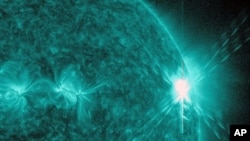The U.S. space agency, NASA, says the sun has emitted a powerful solar flare and a coronal mass ejection, but their radiation does not pose a threat to the Earth.
Scientists say the solar flare that exploded with a burst of intense electromagnetic radiation on the sun’s surface early Tuesday is the largest in four years.
The flare also produced a coronal mass ejection, or CME - a bubble of super-heated gas and charged particles blasted into space from the sun’s upper atmosphere, the corona.
NASA says the Earth is not in danger from either solar event because they occurred on the side of the sun facing away from the planet. However, experts say some radio or satellite communications could be disrupted.
Astronomers say the sun is entering an increasingly violent period of its normal 11-year cycle. The interval of high activity, called the solar maximum, is expected to peak in 2013.
Radiation from solar flares or CMEs that reach the Earth could disrupt power grids and global positioning systems, and interfere with high-frequency airline and military communications.
But CMEs also create beautiful auroras when their charged particles interact with the Earth’s magnetic field. The colorful light displays can be seen glimmering in the night skies over the northern- and southern-most latitudes of the planet.
Coronal mass ejections can occur independently, or they can be released in association with some, but not all, solar flares.
NASA: Sun Emits Powerful Solar Flare, Produces Coronal Mass Ejection











